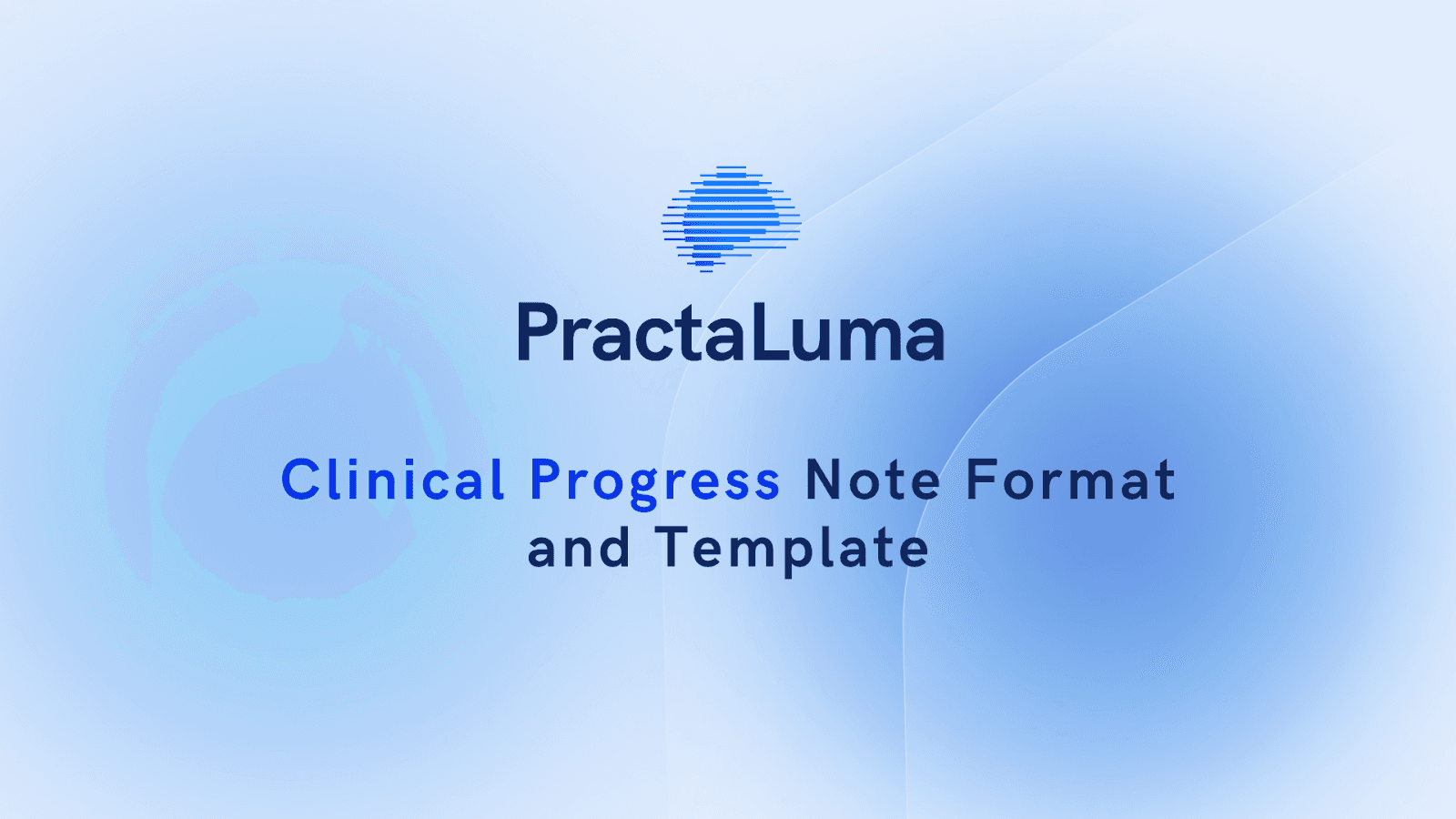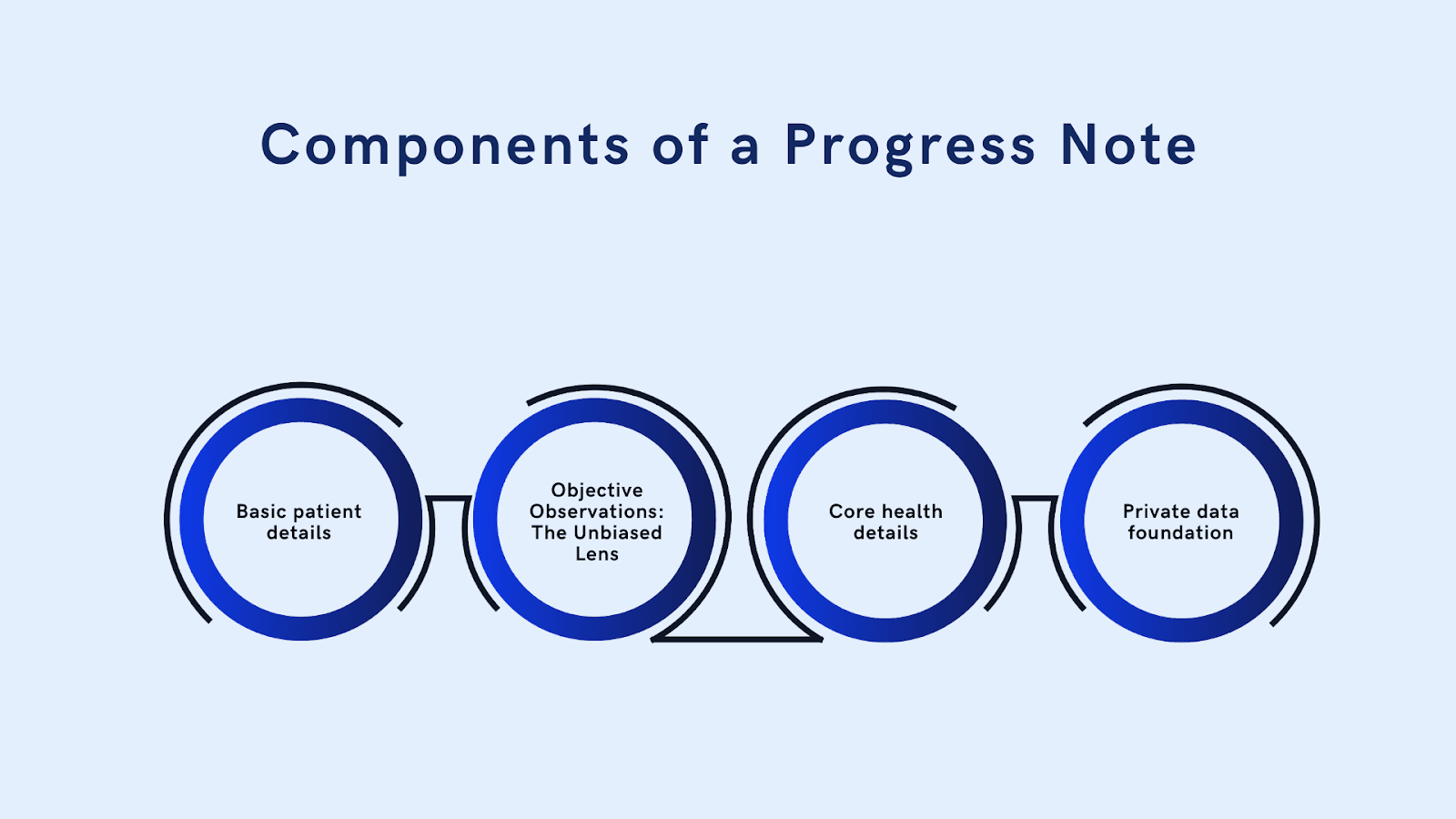
5 May 2025
Clinical Progress Note Format and Template
Clinical progress notes are essential for effective patient care, yet their complexities often go unnoticed. In Australia, healthcare professionals spend a significant portion of their time on documentation, which can impact the quality of patient care. Moreover, communication failures among healthcare providers have been linked to increased preventable adverse effects, many of which are drug-related.
Understanding and utilising standardised progress note formats can streamline this process, enhance communication among healthcare teams, and reduce costly errors.
The importance of clinical progress notes in providing accurate and effective patient care is widely acknowledged; let’s examine their role as a foundation for effective clinical communication and patient care continuity. Progress notes aren’t just records—they’re lifelines that connect healthcare professionals to the pulse of a patient’s journey.
Overview of Clinical Progress Notes
Progress notes are critical to clinical documentation as they facilitate clear communication among healthcare professionals and ensure patients receive seamless, high-quality care.
1. A Communication Tool That Speaks Volumes
Imagine a bustling hospital where patients transition between specialists, nurses, and allied health professionals. Progress notes are the shared language that keeps everyone on the same page, providing concise yet comprehensive insights into a patient’s condition and empowering teams to work cohesively and avoid miscommunication.
Think of it this way:
- For doctors: Progress notes track diagnostic reasoning and treatment evolution.
- For nurses: They highlight shifts in patient response to care.
- For allied health: They document therapeutic goals and progress.
These notes serve as the glue that binds the team, ensuring that no detail—however small—slips through the cracks.
2. Tracking Patient Health and Continuity of Care
Progress notes are like chapters in a patient’s health story. Each entry builds on the last, creating a timeline of care that is invaluable for decision-making.
Why it matters:
- In emergencies, a precise history allows clinicians to act decisively.
- For chronic conditions, notes reveal trends and help refine treatment plans.
- During handovers, they provide an instant snapshot, saving critical time.
Better Picture
Clinical progress notes are more than administrative tasks—they’re transformation tools. They make care transparent, collaborative, and continuous. In an era where efficiency and accuracy are paramount, their role as the bedrock of patient care cannot be overstated.
Now that we’ve explored the overarching significance of clinical progress notes, we can delve into their different formats, which make them both structured and versatile.
These formats are the frameworks that clarify and uniformly organise documentation, ensuring every detail finds its proper place.
Formats for Progress Notes

The true power of clinical progress notes lies in their adaptability. Over time, healthcare has developed structured formats to cater to various clinical needs, allowing professionals to document with precision and ease. Let’s explore the most widely used formats and what makes each unique.
1. SOAP: Subjective, Objective, Assessment, Plan
The SOAP format is the gold standard in clinical documentation, offering a logical flow of information.
Breakdown:
- Subjective: Details the patient’s experiences, such as symptoms or concerns, in their own words.Example: “I’ve had a sharp pain in my lower back for three days.”
- Objective: Clinician’s observations, including physical exam findings or diagnostic results.Example: Blood pressure: 140/90, X-ray: no fractures noted.
- Assessment: A professional diagnosis or interpretation based on the findings.Example: Likely musculoskeletal strain.
- Plan: Next steps in care, such as tests, medications, or follow-up appointments.Example: Prescribe physical therapy and re-evaluate in two weeks.
Why it works: It’s comprehensive yet concise, perfect for tracking complex cases.
2. BIRP: behaviour, Intervention, Response, Plan
Popular in mental health settings, the BIRP format emphasises behaviour and treatment response.
Breakdown:
- Behaviour: Observations or reports of a patient’s actions or mood.Example: The patient appeared anxious, pacing the room.
- Intervention: Steps taken by the clinician to address the behaviour.Example: Engaged the patient in grounding exercises.
- Response: The patient’s reaction to the intervention.Example: The Patient reported feeling calmer.
- Plan: Next steps based on the session.Example: Continue cognitive-behavioural therapy and practicing grounding, weekly sessions.
Why it works: It focuses on actionable outcomes, ideal for therapy progress.
3. DAP: Data, Assessment, Plan
The DAP format is quick and concise, ideal for documenting brief interactions.
Breakdown:
- Data: What was observed or reported during the session?Example: The patient described mild joint pain.
- Assessment: Interpretation or analysis of the data.Example: Likely arthritis flare-up.
- Plan: Recommended course of action.For example, adjust the medication dosage and recheck in 10 days.
Why it works: It’s simple and efficient without sacrificing clarity.
4. GIRP: Goal, Intervention, Response, Plan
The GIRP format is goal-oriented, often used in rehabilitation or therapy settings to track progress toward specific patient objectives.
Breakdown:
- Goal: The desired outcome for the patient.Example: Improve mobility in the left knee post-surgery.
- Intervention: Actions or therapies implemented to achieve the goal.Example: Initiated physiotherapy exercises twice daily.
- Response: The patient’s progress or reaction to the intervention.Example: The Patient reports reduced pain and improved range of motion.
- Plan: Future steps or adjustments to the intervention.Example: Increase exercise intensity and re-evaluate in one week.
Why it works: It aligns every action with a defined objective, making it highly effective for tracking rehabilitation or progress-based care.
Each format has strengths, and the choice depends on the specific clinical context. Whether you need the depth of SOAP or the goal-oriented precision of GIRP, understanding these frameworks empowers you to document more effectively and stay aligned with patient care goals.
Now that we’ve covered the popular formats for clinical progress notes, let's focus on the key components that make a note complete and impactful. These elements are building blocks that ensure ever
vital detail of the patient's journey is included.
Components of a Progress Note

Every progress note is like a well-composed symphony. Each section contributes to harmony, ensuring clear communication and precise documentation. Let’s explore these essential components in detail.
1. Patient's Personal Information: The Starting Point
Accuracy begins with patient identifiers like name, age, and medical record number. These details ensure no mix-ups, especially in an environment with high patient volumes.
Why it’s essential:Misidentification accounts for a significant percentage of medical errors globally. A missing detail could lead to critical care mistakes.
Tip for excellence: Always double-check identifiers when documenting sensitive cases or complex diagnoses.
2. Objective Observations: The Unbiased Lens
Objective data, including measurable facts such as vital signs, physical exam findings, and diagnostic results, forms the backbone of clinical documentation.
Imagine this:
- A note that reads: “Patient looks unwell”, leaves room for ambiguity.
- A better entry: “Patient appears pale, BP 90/60, HR 110 bpm.”
Objective observations eliminate guesswork, giving a clear snapshot of the patient’s condition.
3. Symptom and Condition Overview: The Heart of the Note
This section narrates the patient’s experience and vividly illustrates their health status. It captures what the patient feels and how their symptoms are evolving.
What makes it powerful:Including direct quotes from patients, such as “I’ve been feeling short of breath for three days,” adds authenticity and clarity.
Pro Insight:Detail progression or triggers of symptoms to aid in diagnostic precision.
4. Intervention and Treatment Plan: The Roadmap
This is where action meets intention. Documenting interventions and plans ensures the care pathway is clear for all involved.
What to include:
- Prescriptions and dosages
- Referrals or diagnostic tests
- Follow-up instructions
An Example of Excellence:Instead of writing, “Started medication,” specify: “Prescribed amoxicillin 500 mg twice daily for 7 days.” Clarity ensures seamless continuity of care.
These components work together to create a progress note that is not only functional but also insightful. Precision capture ensures that no information is lost in translation, paving the way for improved patient outcomes and seamless communication among healthcare providers.
Now that we’ve examined the components of a progress note, the next logical step is to understand how to elevate your documentation practices. Writing practical progress notes isn’t just about filling in the blanks—it’s about crafting clear, concise, and actionable records.
Writing Effective Progress Notes
Writing progress notes can feel like second nature for seasoned clinicians, but even the best of us can slip into bad habits. Adequate documentation balances thoroughness and efficiency. Here’s how to get it right every time.
1. Document Promptly After Sessions: Time is Key
Procrastinating documentation is a slippery slope. Waiting too long can lead to forgotten details or incomplete entries.
Why it’s essential:
- Memory fades fast, and critical observations may be overlooked.
- Delayed notes risk compliance issues during audits or legal proceedings.
Pro Tip: Treat documentation as an extension of the session itself. Jot down notes immediately after each interaction to ensure accuracy and completeness.
2. Utilise Clinical Management Software: Work Smarter
Leverage technology to reduce manual errors and improve efficiency. Clinical management software can assist with templates, prompts, and automated suggestions.
Benefits:
- Preloaded templates tailored to specific specialities.
- Spell-check and abbreviation expansions to enhance clarity.
- Instant access to patient histories for continuity.
Example in Action: Use voice-to-text dictation to capture notes during a consultation, then refine them post-session for polish.
3. Ensure Conciseness and Clarity: Keep it Crisp.
Healthcare professionals often juggle multiple patients, leaving little time to decode verbose or ambiguous notes. Conciseness isn’t about cutting corners; it’s about communicating effectively.
Consider this comparison:
- Ambiguous: “Patient doing better.”
- Concise: “Patient reports reduced joint pain; mobility improved by 20%.”
Clear notes speed up decision-making and improve collaboration within care teams.
4. Avoid Ambiguous Abbreviations: Clarity Over Speed
While abbreviations can save time, they can lead to confusion, especially in interdisciplinary teams.
For Example:
- “OD” might mean “once daily” to some and “right eye” to others.
- Instead, write “right eye” or “once daily” explicitly.
Golden Rule: If there’s any chance of misinterpretation, spell it out.
Every progress note is a reflection of your clinical expertise. By adopting these strategies, you ensure your documentation isn’t just compliant but a true asset to patient care. The goal isn’t just to meet standards—it’s to raise them.
Having established the best practices for writing progress notes, let’s focus on how to make the process more efficient. After all, time is a precious commodity in healthcare, and finding ways to streamline documentation can significantly enhance your workflow.
Examples of Progress Note Templates
Templates act as a guiding framework, ensuring consistency and completeness in your documentation. Let’s examine a few popular examples and how they can elevate your clinical notes.
1. SOAP Note Template: Comprehensive Patient Documentation
For a good reason: the SOAP format is the foundation of clinical documentation—it’s clear, logical, and highly adaptable.
Example Template:
- Subjective: Patient’s reported symptoms or concerns.Example: “The patient states, ‘I’ve been feeling fatigued and short of breath after minimal activity.’”
- Objective: Observable facts, test results, or vital signs.Example: BP: 130/80, pulse: 88 bpm, chest X-ray: normal findings.
- Assessment: Diagnosis or clinical interpretation.Example: Likely anemia due to recent blood loss.
- Plan: Next steps in care.Example: Order complete blood count (CBC), iron studies, and follow-up in one week.
Why it works: SOAP ensures a holistic view of the patient’s condition, making it suitable for various specialties.
2. DAP Note Template: Quick and Effective
The DAP format is perfect for situations where brevity and focus are essential.
Example Template:
- Data: Relevant observations or patient statements.Example: “Patient describes mild knee pain aggravated by activity.”
- Assessment: Professional analysis or interpretation.Example: Likely early-stage osteoarthritis based on history and symptoms.
- Plan: Recommendations or interventions.Example: Prescribe low-impact exercises, consider NSAIDs for pain management, and follow up in three weeks.
Why it works: DAP is efficient yet impactful, ideal for busy clinical settings.
3. GIRP Note Template: Goal-Oriented Documentation
The GIRP format emphasises tracking progress toward specific rehabilitation or therapy-focused care goals.
Example Template:
- Goal: Define the desired outcome.Example: Increase shoulder mobility post-surgery to 90% within six weeks.
- Intervention: Outline the actions taken.Example: daily stretching and biweekly physical therapy sessions. were prescribed
- Response: Document patient progress.Example: Patient reports improved range of motion, now at 75%.
- Plan: Specify the next steps.Example: Continue the current regimen and reassess it at the next session.
Why it works: GIRP aligns every action with measurable progress, making it perfect for long-term care plans.
Templates are a starting point, not a one-size-fits-all solution. Customising them to fit your clinical needs and workflow ensures you get the most value while maintaining accuracy and compliance.
PractaLuma’s clinical documentation solutions include prebuilt SOAP, GIRP, and other formats. These tools help simplify your documentation without sacrificing detail. They also offer ready-to-use, customisable templates tailored to your practice.
Efficiency Strategies for Writing
Creating high-quality progress notes doesn’t have to be a time-consuming ordeal. You can maintain thorough documentation with the right strategies while reclaiming valuable time. Here’s how:
1. Use Shorthand During Sessions: Capture the Essentials
WJotting down shorthand notes while interacting with patients can help you quickly capture key points without disrupting the flow of the conversation.
How it works:
- Develop a personal system of symbols and abbreviations that are intuitive and easy to expand later.
- Focus on capturing critical details, like symptoms, interventions, and next steps.
Example:Instead of writing, “The patient reports occasional headaches in the morning,” jot down, “AMHA, occasional.” After the session, expand this shorthand into complete sentences.
2. Incorporate Clinical Documentation Software: Leverage Technology
Modern software tools are designed to make documentation faster and more accurate.
Features to Look For:
- Voice-to-Text Technology: Dictate your notes during or immediately after the session for faster completion.
- Predefined Templates: Use preloaded formats for SOAP, GIRP, or other styles to save setup time.
- Auto-fill Features: Automate repetitive fields like patient demographics or common interventions.
Example in Practice:Software like PractaLuma streamlines progress note creation, ensuring consistency while reducing manual effort.
3. Establish a Consistent Routine: Build a Habit
Efficiency thrives on consistency. Set a routine for documentation that aligns with your schedule and clinical flow.
Steps to Build a Routine:
Allocate time at the end of each session for immediate note-taking.
Set aside a block of time daily for reviewing and finalising notes.
Prioritise the most complex cases first to avoid delays.
Why it works:A steady rhythm eliminates procrastination and reduces the stress of catching up on overdue documentation.
By incorporating these strategies, you can write progress notes that are both comprehensive and time-efficient.
The key is balancing speed and accuracy, ensuring every note serves its purpose without wasting precious time with patients.
With strategies in place to streamline your documentation process, it’s time to explore real-world examples of progress note templates. These templates simplify your workflow and provide a structured approach to capturing essential details.
Conclusion
Clinical progress notes are the backbone of effective patient care. They don’t just capture what happened—they pave the way for what comes next. By maintaining consistent, clear, and comprehensive records, healthcare professionals ensure better communication, improved patient outcomes, and seamless continuity of care.
In today’s fast-paced healthcare environment, leveraging technology is no longer optional—it’s essential. Intelligent documentation tools, like those offered by PractaLuma, empower clinicians to save time, reduce errors, and focus on what truly matters: providing exceptional care.
Ready to take your clinical documentation to the next level? PractaLuma’s innovative solutions offer:
- Customisable Templates: Tailored formats for SOAP, GIRP, DAP, and more.
- Intelligent Automation: Features like voice-to-text and auto-fill fields to save time.
- Compliance and Security: Built to meet the highest standards in healthcare documentation.
With Practaluma, you can reduce administrative burdens, improve accuracy, and ensure that every progress note accurately reflects your expertise.
Try PractaLuma Today and experience the future of clinical documentation.